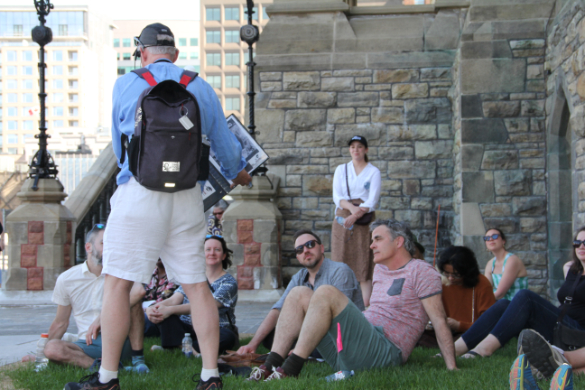Student Blog: Modern Community Building

We are continuing our series of student blogs with a number of reflections on the “Small Modernisms” symposium, a public event held at the Carleton Dominion-Chalmers Centre on May 12-13, 2022. The event was organized by Professors Michael Windover and Dustin Valen. The blogs were written by undergraduate students in the History and Theory of Architecture and Art History programs in Carleton’s School for Studies in Art and Culture.
By Armand Caloumenos
“Small Modernisms” was an eye opening and informative event that showcased a broad range of topics that architectural historians are working on. The presentations revealed how architectural research is being approached from a number of different angles and can provide unique insights into the experience of diverse groups and communities.
One such group was children. Leslie Korrick’s paper, “Thinking Big, Building Small: The Overland Drive Public School Adventure Playground,” examined adventure playgrounds, how they came to be, the issues they presented, and why they are rarely seen today. Her paper showed how child psychology influenced the design of landscapes. Adventure playgrounds, she explained, were meant to develop children’s sense of collective responsibility by strengthening their individualism and providing an inclusive space for all children to work together to solve problems.
The demise of adventure playgrounds is also evidence of how architectural spaces are responsive to broader societal concerns. Why did these adventure playgrounds not take off? Why do they seem to be a radical idea, even today? After her presentation, Korrick explained to me that during the 1980s parents started to become more cautious of their children’s play spaces. They expressed concern over the safety of adventure playgrounds and demanded play spaces where children wouldn’t injure themselves. Her research on the design and creation of an adventure playground in Don Mills offered a unique perspective that I hadn’t thought about before and highlighted the kinds of topics that architectural history can fall into.
Another presentation from the event that addressed children in postwar society, as well as community activism, was George Kapelos’s presentation entitled “The Britannia Community Services Centre – testing the language of Small.” In it, Kapelos examined the community-oriented design process behind the Britannia Community Services Centre, which aimed to be a place where all members of the community, especially children and young adults, could gather for events, meetings and spend time together. Britannia needed a place like this, according to the Britannia High School’s Association to Tackle Adverse Conditions. Young activist and council president Joe Ferrera said in a 1969 speech to the community: “Man, imagine what it would be like to have a swimming pool, a rink, or a track in our neighbourhood!” Kapelos described how multilingual posters invited the public to pitch design ideas, and how the architects used pattern languages drawn from the work of British-American design theorist Christopher Alexander to translate these ideas into key features of the project, including a generous entrance area and a central, multi-purpose meeting space. The result of the process was a place for the people of Britannia to come and feel welcome. The Community Services Centre is still a thriving place for the community, demonstrating that when architects and designers listen to community members and take note of their needs and concerns, something great can be realized and be successful in the long term.
Walking tours were another aspect of the symposium that showcased the unique perspectives that architectural historians can offer. One example of this was the People’s History Walking Tour given by Brian McDougall. A former public servant and lifelong activist, McDougall’s tour charted social change across Canada by focussing on the role of the nation’s capital as a meeting point for various protest movements. In addition to historical research, McDougall drew from personal experience: he was present for many of these events and often based his stories on firsthand observation. The tour highlighted how architecture has accommodated historical events. Everything that happens in history takes place somewhere, and spaces help shape these events. Similarly, tour participants heard stories about historical events within the space they occurred. The result was an unparalleled learning experience.
“Small Modernisms” was an engaging, eye-opening and unique experience, showcasing how architectural history can offer unique perspectives on postwar Canadian society. The event showed how architectural history is often the backdrop for countless other discourses and can open up bountiful avenues for research. To students that are studying architectural history, events like “Small Modernisms” are an incredible aid, as they allow for the broadening of your views on the built environment and link architecture to society.